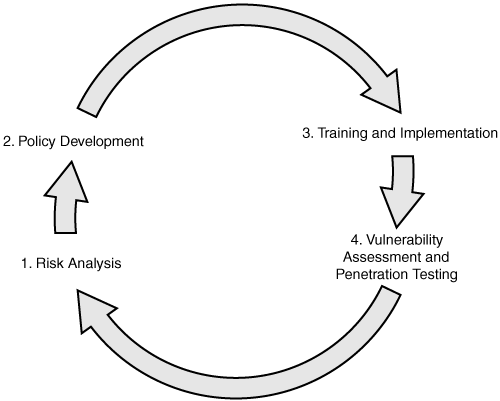What Security Is and Isnt
What Security Is and Isn t
Computer security is unlike other forms of security. Products such as locks, safes, and steel doors give clear ratings on what types of attacks they can withstand and how long they can withstand them. Most IT security products do not come configured in such a manner. These devices state only that they will prevent, block, drop, or protect from specific risks. Technology has failed to offer one complete perfect solution. Sure, you will find vast quantities of security technologies advertised in all the latest glossy security magazines and at security trade shows, but simply throwing money at products isn't the real solution. Security is not technology.
Misconfiguration, improper installation, and poor management are other causes of poor security. I have seen IT workers and managers involved in poor practices. I'll never forget the time a government agency showed me a firewall that was supposed to be protecting the internal network. The problem was that it wasn't even hooked to the network. It was configured in loop back mode. Security is not the administration.
Policies are another item pointed to when someone speaks of security. Many organizations don't have a well-defined security policy. Others have policies but they are poorly written or no one follows them because there are no consequences built in to the policy. After all, it's just a paper document. Policies are not security.
By now, you may be wondering what I think security is. Security is a process. Yes, security requires technology, people, and policies; however, that is not enough. Security is a process that requires input from the entire organization to be effective. It involves work on a proactive basis, such as patching vulnerable systems and monitoring audit files and IDS systems' activity logs. Security also requires support from senior management; it includes risk analysis, good implementation, employee training, patch management, and periodic vulnerability assessments. Figure 1.1 outlines the flow of this process.
Figure 1.1. The risk assessment process.

Introduction to Assessing Network Vulnerabilities
- Introduction to Assessing Network Vulnerabilities
- What Security Is and Isnt
- Process for Assessing Risk
- Four Ways in Which You Can Respond to Risk
- Network Vulnerability Assessment
Foundations and Principles of Security
- Foundations and Principles of Security
- Basic Security Principles
- Security Requires Information Classification
- The Policy Framework
- The Role Authentication, Authorization, and Accountability Play in a Secure Organization
- Encryption
- Security and the Employee (Social Engineering)
Why Risk Assessment
- Why Risk Assessment
- Risk Terminology
- Laws, Mandates, and Regulations
- Risk Assessment Best Practices
- Understanding the IT Security Process
- The Goals and Objectives of a Risk Assessment
Risk-Assessment Methodologies
- Risk-Assessment Methodologies
- Risk-Assessment Terminology
- Quantitative and Qualitative Risk-Assessment Approaches
- Best Practices for Quantitative and Qualitative Risk Assessment
- Choosing the Best Risk-Assessment Approach
- Common Risk-Assessment Methodologies and Templates
Scoping the Project
- Scoping the Project
- Defining the Scope of the Assessment
- Reviewing Critical Systems and Information
- Compiling the Needed Documentation
- Making Sure You Are Ready to Begin
Understanding the Attacker
- Understanding the Attacker
- Who Are the Attackers?
- What Do Attackers Do?
- Reducing the Risk of an Attack
- How to Respond to an Attack
Performing the Assessment
- Performing the Assessment
- Introducing the Assessment Process
- Level I Assessments
- Level II Assessments
- Level III Assessments
Tools Used for Assessments and Evaluations
- Tools Used for Assessments and Evaluations
- A Brief History of Security Tools
- Putting Together a Toolkit
- Determining What Tools to Use
Preparing the Final Report
- Preparing the Final Report
- Preparing for Analysis
- Ranking Your Findings
- Building the Final Report
- Contents of a Good Report
- Determining the Next Step
- Audit and Compliance
Post-Assessment Activities
- Post-Assessment Activities
- IT Security Architecture and Framework
- Roles, Responsibilities, and Accountabilities
- Security Incident Response Team (SIRT)
- Vulnerability Management
- Training IT Staff and End Users
Appendix A. Security Assessment Resources
Appendix B. Security Assessment Forms
- Information Request Form
- Document Tracking Form
- Critical Systems and Information Forms
- Level II Assessment Forms
Appendix C. Security Assessment Sample Report
- Appendix C. Security Assessment Sample Report
- Notice
- Executive Summary
- Statement of Work
- Analysis
- Recommendations
- Conclusions
Appendix D. Dealing with Consultants and Outside Vendors
- Appendix D. Dealing with Consultants and Outside Vendors
- Procurement Terminology
- Typical RFP Procurement Steps
- Procurement Best Practices
Appendix E. SIRT Team Report Format Template
EAN: 2147483647
Pages: 138
- ERP Systems Impact on Organizations
- Challenging the Unpredictable: Changeable Order Management Systems
- The Second Wave ERP Market: An Australian Viewpoint
- Enterprise Application Integration: New Solutions for a Solved Problem or a Challenging Research Field?
- Distributed Data Warehouse for Geo-spatial Services
